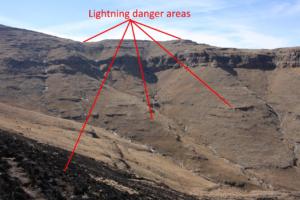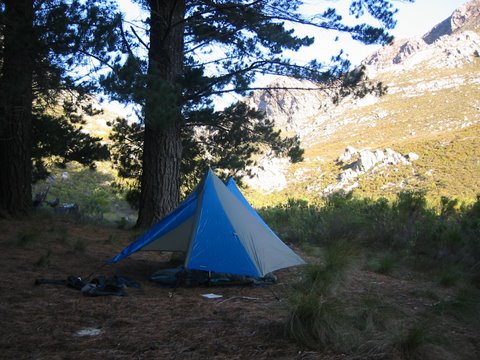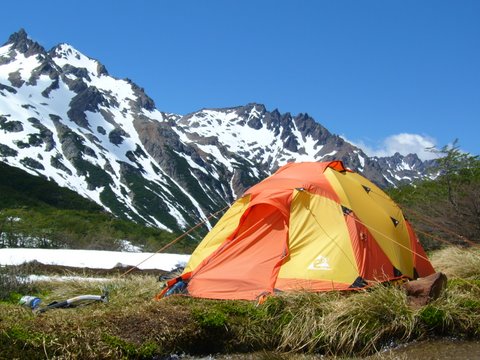Watch out for the following hazardous conditions in the Drakensberg
1 Bad visibility caused by bad weather (mist, rain, snow) or by darkness is a major hazard in the mountains. This lack of visibility causes other problems to develop. For instance, any lack of visibility can cause walkers to get lost. This in turn causes people to take short cuts along unknown routes, accidentally walk off steep ground or cliffs or to have party members get dangerously tired or dehydrated.
2 Snow falls cause extremely cold and wet conditions. Remember that although snow is seen as “fun” it is not pleasant to walk in falling snow, neither to camp in it. Watch for hypothermia. When snow falls thickly it can become almost impossible to walk through and can trap a whole group for days at a time. Snow and ice can also make a simple path into a very dangerous place especially if there is a steep drop off nearby.
3 Rock falls happen from time to time especially during heavy rain or snow. Watch for loose overhanging rock in places where a hiking party must pass nearby.
4 Lightning is major problem in the summer months in most areas of southern Africa. If a storm is approaching, move away from ridges or the summits of peaks. Get into lower ground with plenty of high points set well away from the party. A good place is the safe zone near to a small cliff. To work out where to sit, estimate the height of the cliff and then sit the same distance away from it at the base. Then to make it safer, get members to sit down on their haunches with their feet on any insulating material such as a rucksack or ground sheet. Place any large metal items well away from the party (e.g. tent poles) Sitting on the haunches is the best way to sit out a storm, since if a strike happens close by and current runs through the ground, it will most likely run through only the persons legs and not the vital organs and head. Lying down on the ground will mean that any current will run right though the whole body. Also get the party to spread out (minimum of 10m apart). In the event of a person being struck it will have less chance of jumping across and hitting more members.


Avoid sheltering near or under isolated trees, buildings or rock pinnacles. Rock fissures and small caves are not good places to shelter either as the current tends to travel along these lines of weaknesses. Also be careful when near metal fences. Lightning can strike the fence many kilometers away and the current flows along the fence, injuring anyone holding it.
5 Flash floods can occur in narrow valleys or streambeds when a storm occurs up stream. Remember that the storm could be so far away you may not know of its presence. Small streams can become flooded in a matter of seconds.
6 Rain and wind is a very common mountain hazard. Conditions become slippery, wind may be strong enough to make people stumble about and even destroy tents. Watch for hypothermia in these conditions.
7 Hypothermia is a condition when the body’s core temperature drops below 32?C . This condition is called Mild hypothermia. If untreated the body temperature can drop further to temperatures as low as 28?C and is called Severe hypothermia. Mild hypothermia is a dangerous condition which is usually brought on in the mountains by a person having wet clothing coupled with heat loss from windy conditions. The early symptoms of mild hypothermia are shivering, feeling cold, irritability, impaired speech, un-coordinated movements and stumbling when walking.
A leader must learn to recognise these symptoms in members of their party. The party must stop as soon as possible, get the patient into dry, warm clothes and out of the wind. They can be given hot, sugared drinks to aid recovery.
If unchecked Severe hypothermia can set in. This is a life threatening condition! Shivering stops, the patient cannot walk or stand, they become completely incoherent, will often say they “feel warm” and even take their clothes off. One can also take their temperature to confirm their dangerous state.
If severe hypothermia occurs to a member of a party the whole group must stop and set up camp immediately. Get the patient into dry clothes and into a dry sleeping bag under shelter.
Do not try to apply too much heat too quickly to the patient’s extremities, as this draws warm blood away from the vital organs. Rather let the patient slowly warm up in a sleeping bag with warm items applied to the chest region (e.g. hot water bottle or warmed rock).
For both Mild and Severe hypothermia a good way to warm the patient is to have another person climb into the sleeping bag with them. If severe hypothermia has been encountered the patient should be moved to hospital as soon as possible.
Remember that if the body temperature carries on dropping they will eventually lose consciousness and die soon afterwards.
8 Heat exhaustion and dehydration is usually caused by hard physical work during very hot conditions in direct sunlight. The body loses too much water and cannot get rid of heat fast enough. The patient will get very thirsty, feel dizzy, tired, their tongue may become dry and they can even lose consciousness. Their eyes may become sunken and their body temperature my rise slightly.
To treat this condition move the patient to some shade, remove some clothing, pour water onto their clothing to aid cooling, give them cold water with a small amount of salt and sugar added. If their body temperature continues to rise they must be taken to hospital as soon as possible as this is a sign of probable heatstroke.
9 Heatstroke can be caused by the same conditions as Heat exhaustion and has similar symptoms. Symptoms can then also include delirium, convulsions and un-consciousness. The rectal temperature will rise to above 40?C. This is a very serious situation and most patients die unless treated immediately. Treat as for Heat exhaustion but also elevate the legs, fan the patient, ensure the air way is open if the patient becomes unconscious. Move to hospital as soon as possible.
10 Altitude Sicknesses are rare in the Drakensberg, but a few cases of Acute Mountain Sickness have been recorded and diagnosed by a doctor. Elsewhere in Africa, however, these set of illnesses can be a real problem and even life threatening. Mountains such as Mt. Kenya, Kilimanjaro and Mt. Stanley are all at the altitudes than can cause illnesses.
Rising altitude causes less air pressure and by proportion, less oxygen to breathe, a drop in blood PH and water retention. The chemical process in the human body by which this happens, is very complicated. The symptoms however, are usually clear to the observer and very apparent to the patient.
Symptoms and Types of Illnesses
Acute Mountain Sickness- Although this is least dangerous condition it will still cause horrible symptoms and make life extremely unpleasant.
– Tiredness/ headaches/ sleep apnea
Pulmonary Edema– As Acute Mountain Sickness with added “rails” in chest/ coughing, fluid build up in the lungs, causing drowning- this is a LIFE THREATENING CONDITION – DESCEND IMMEDIATELY AND SEEK RESCUE/MEDICAL HELP.
Cerebral Edema– fluid forming on the brain- severe headaches/ disorientation/ AN EXTREMELY LIFE THREATENING CONDITION! DESCEND IMMEDIATELY AND SEEK RESCUE/MEDICAL HELP.
Treatment and Prevention
- Ascend slowly > 3000m not more than 300m per day if possible
- Climb high- sleep low. Climb up high, then come down and camp for the night.
- Drink lots of water
- Diamox –brings blood pH to normal and relives symptoms of Acute Mountain Sickness (beware of people with sulphur allergies)
- Descend in the altitude if symptoms do not resolve in 12 hours.
11 Wild Fires
Hiking in South Africa has the extra hazard of being caught in an uncontrolled fire, such as grass of low lying scrub such as vynbos that covers the western part of the country. In places like the Drakensberg, grass fires are also purposefully started in the winter months as part of eco management by the land managers. Controlled or uncontrolled fires can occur in the Drakensberg region from June to October.
If you find yourself in the path of such a fire do the following:
- Get into a big river bed if there is one close by.
- Get into thick temperate indigenous forests found on the southern slopes.
- Carry matches or lighter- start a fire yourself and burn a big patch of grass and then step into the area once the heat has dissipated.

